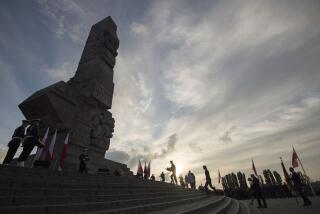14 Killed by Soviets Are Mourned : Lithuania: Both Roman Catholic and Russian Orthodox archbishops decry deaths. Thousands watch silently as coffins are driven through streets.
- Share via
VILNIUS, Soviet Union — In a display of collective grief that was also a massive show of support for Lithuania’s leadership, half a million people came into the streets of this Baltic capital Wednesday to help bury their compatriots killed by the Soviet army.
His voice breaking with emotion at the funeral Mass, the Roman Catholic archbishop of Vilnius, Julijonas Steponavicius, said that all Lithuania wept for the 13 men and one woman killed when Soviet paratroopers attacked Vilnius broadcast installations three days earlier.
They had not died in vain, he said.
“These people in charge, these Communists, made a mistake,” Steponavicius, wearing a violet bishop’s miter, told mourners packed in Vilnius’ cathedral. “They wanted to take charge of our government through a coup d’etat. These victims stopped their plans, but whether they have just been postponed is unclear.”
The archbishop, who was released from internal exile only a year and a half ago by Soviet authorities and permitted to return to Vilnius, implicated President Mikhail S. Gorbachev in the blood bath.
Gorbachev, he noted, has said publicly that he was told of the army’s actions only after the fact. “We know the games of empire,” Steponavicius commented. “They are blood and lies.”
The archbishop, an influential figure in this largely Catholic land, said Lithuanians should now dedicate themselves to achieving “full independence.”
The local Russian Orthodox prelate had delivered an extraordinary address at the start of the service to put the lie to claims from Moscow that the Lithuanian government’s quest for independence has brought the republic to the brink of Lebanon-style ethnic war.
“We Russians should feel ourselves especially close to this tragedy because we are directly guilty, and this is our shame,” Chrisostom, the Orthodox archbishop for Lithuania, told the mourners.
“The blood of peaceful people has been shed, people who were close to us. This bloodshed should not divide us but unite us in a common goal.”
At 11 a.m., from the indoor arena where the victims had lain in state for three days, the coffins of nine of them began to move slowly on open-sided hearses toward the city’s center as throngs of people lining the sidewalks watched in silence.
The body of Loreta Asanaviciute, 24, was the first. A man preceded the hearse holding her portrait and a single white lily. The Vilnius garment worker was crushed to death by a tank during the army’s storming of the Vilnius television tower.
The procession crossed over a bridge dominated by Stalin-style statues of Red Army soldiers and workers. By accident or design, the dead were carried past the headquarters of Lithuania’s Communist Party, now the sworn enemy of Lithuanian President Vytautas Landsbergis and the republic’s Parliament.
Lithuanians--30 deep and more in places--watched the dead pass in respectful silence. As an emblem of sorrow, tens of thousands held candles with a paper cup or sheet of plastic around them to protect the flame from the wind.
Pallbearers with black sashes gently placed the coffins side by side on the red carpet before the altar at the Vilnius cathedral, which until the easing of Kremlin constraints on religion three years ago had been turned into an art museum.
Each coffin was topped with Lithuania’s yellow, green and red flag, which has replaced the Soviet Union’s red hammer and sickle by act of the republic’s Parliament.
Landsbergis himself did not attend the funeral, and an official in the Lithuanian Parliament’s information bureau said the absence was due to security reasons.
The Lithuanian leadership was represented by Kazimieras Motieka, the vice president, and members of the Supreme Council, the Parliament.
On the square outside the cathedral, where rallies had been staged over the past three years to demand the restoration of the independence that Lithuania enjoyed from 1918 to 1940, so many people were massed that police assigned to crowd control said they had no idea of the total number.
High-ranking officers, however, said there were no fewer than half a million people in the streets of Vilnius, a city of 600,000.
Banners showed that mourners had come from the port city of Klaipeda, from Kaunas and throughout the republic, and a reporter talking to people in the crowd found some ethnic Russians and Poles as well as Lithuanians.
It was already growing dark when the cortege reached Antakalnis Cemetery, about a mile and a half from the cathedral. In the tensest moment of the day, the marchers passed the gate of the Soviet army’s Higher Command School of Radio-Electronics for Air Defense.
Many glowered at the red star on the army school’s gate but said nothing. An army colonel told a reporter that the gate had been shut for the day because disorders might occur during the funerals. A truck was parked against the gate on the inside so that its metal doors could not be shoved in.
With the hearses came thousands of people bearing evergreen wreaths and baskets of flowers to put on the graves.
On the terrace of a hillside, under tall pines, nine graves had been dug in a row. A gray stone set in front of each bore the name of the dead in gold letters. A giant crucifix hewn from oak loomed over the site.
The four other civilian victims of the military assault were to be buried in family plots or in hometowns elsewhere in Lithuania. A Soviet soldier also died; Soviet officials said that he was shot in the back with a Kalashnikov assault rifle, the standard-issue weapon for the paratroops.
More to Read
Sign up for Essential California
The most important California stories and recommendations in your inbox every morning.
You may occasionally receive promotional content from the Los Angeles Times.













